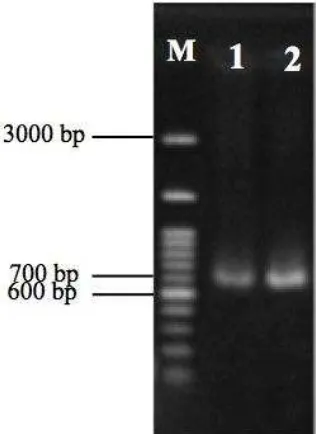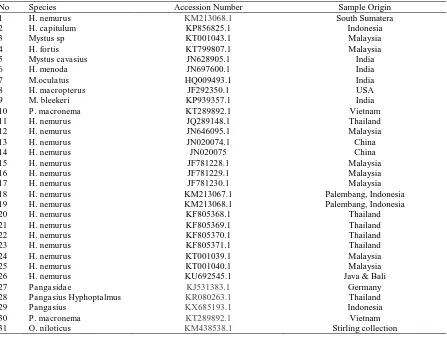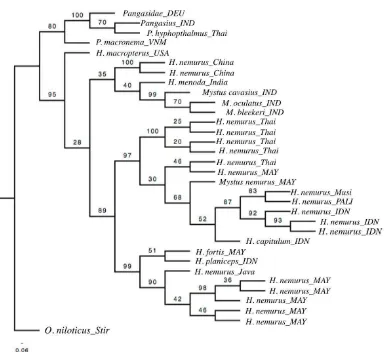Genetics of Aquatic Organisms 1: 43-48 (2017)
www.genaqua.org ISSN 2459-1831 DOI: 10.4194/2459-1831-v1_2_01
RESEARCH PAPER
© Published by Central Fisheries Research Institute (CFRI) Trabzon, Turkey
DNA Authentication of Asian Redtail Catfish Hemibagrus nemurus from
Musi and Penukal River, South Sumatra Indonesia
Introduction
Catfishes are an important economic livelihood at water resource in South Sumatra-Indonesia. Hemibagrus has been cultured for food in East and Southeast Asia, mainly in Peninsular Malaysia and Thailand. It was widely dispersed throughout Sundaic and mainland Southeast Asia, which was thought to be conspecific due to consistent differences in morphology and morphometric (Ng & Kottelat, 2013). Throughout its geographical range, species of Hemibagrus are valuable food fishes and species identification is of importance for sustainably to utilize this species complex (Dodson & Lecomte, 2015). Asian redtail catfish (Hemibagrus nemurus) (Valenciennes, 1840), local people known as baung fish, is also one of popular raw material for delicacy food in Sumatra. ARC spread around Asia and Africa continent, while in Indonesia inhabit water resource in Sumatra, Kalimantan and Java for instance Jakarta, Karawang, Garut, Surabaya, Malang, Pasuruan, Palembang, Bengkulu, Muara Kampeh, Banyu Asin, Lake of Singkarak, Barito, Rasau, Kapuas and Sambas (Roberts, 1989). This species lives in most habitat types, but most frequent in large muddy rivers, with slow current and soft bottom (Kotellat, 1998). It is primarily an inhabitant of large rivers, and has been
described as an opportunistic predator that feeds on fish, aquatic and terrestrial invertebrates (Rachmatika, 2003). (Hutan Rawa Gambut Merang-Kepayang/HRGMK, Banyuasin) (Iqbal, 2011). With many different species of Bagridae around Sumatra, there is a pressing need for better tools for species authentication through DNA molecular (Rajiv and Chauhan, 2010). Mitochondrial DNA can be used to investigate evolutionary process with high resolution (Brown, George & Wilson, 1979). Sequencing of this region has been widely used to discriminate species level (Nagl et al., 2001) and population study (Rognon & Guyomard, 1997; D’Amato, Esterhuyse, Waal, Brink & Volckaert, 2007). Cytochrome c oxidase subunit I is one of mtDNA gene, which is conserve, used for distinguishing species and population.
The conserved sequence of the 5’ region of the
mitochondrial gene cytochrome oxidase subunit I (COI or Cox1), a platform for the universal DNA barcoding of life, has been widely used for
Mochamad Syaifudin
1,*, Dade Jubaedah
1, Muslim Muslim
1, Ayu Daryani
11 Sriwijaya University, Faculty of Agriculture, Program Study of Aquaculture, Jl. Palembang-Prabumulih Km 32, 30862, Indralaya, South Sumatra, Indonesia.
* Corresponding Author: Tel.: +62.711 580664 E-mail: msyaifudin@fp.unsri.ac.id
Received 29 September 2017 Accepted 25 November 2017
Abstract
Asian Redtail Catfish (Hemibagrus nemurus) is highly economic important catfish in South Sumatra. Investigating DNA authentication is of importance for species conservation and breeding selection. Cytochrome C Oxidase subunit I is one of mitochondrial DNA markers used for species barcoding in freshwater, brackishwater and marine fish. This research aims to explore the use of COI gene for species barcoding, constructing phylogenetic tree of Asian Redtail Catfish (ARC). The methods used in the research consisted of DNA extraction, PCR (Polymerase Chain Reaction) amplification and sequencing mtDNA COI gene of ARC obtained from Musi and Penukal Rivers (South Sumatra). A 572 and 596 base pairs of partial coding sequences were obtained representing each river. Phylogenetic analyses indicated that ARC was at the same cluster from Bagridae family, and different cluster from others catfish, Pangasius sp and Oreochomis niloticus. Further study using more species of Bagridae and habitat are needed to investigate the diversity of DNA from South Sumatra water resources
44
distinguishing, for example, species in the Persian Gulf (Asgharian, Sahafi, Ardalan, Shekarriz & Elahi, 2011), Australian fish (Ward, Zemlak, Innes, Last, & Hebert, 2005), marine fishes in the northwest Atlantic Ocean, Canada (McCusker, Denti, Van Guelpen, Kenchington & Bentzen, 2013) and tilapia species (Shirak et al. 2009; Wu & Yang, 2012; Syaifudin Penman & McAndrew, 2015). The objective of the research described here was to distinguish between Bagridae species and to construct phylogeny tree.
Materials and Methods
Biological Materials
A total of 10 individuals of ARC were collected from two different rivers at South Sumatra Provinces (Musi & Penukal), Indonesia. All fin clips were preserved in 99% ethanol (1:10 w:v) and stored at
-20°C until required.
Genomic DNA Extraction
Fin clips sample were used to extract DNA from all samples. Total genomic DNA was extracted using the Realpure Genomic DNA Extraction Kit (Durviz S.L) following the manufacturer’s protocol. An RNAse incubation step was included to minimise RNA contamination, with each precipitated DNA sample being finally resuspended in 5 mM Tris, pH8.5. Those samples that passed quality control (no observable RNA and comprising predominantly high molecular weight DNA) were selected for use and
diluted to a concentration of 50 ng/μL in 5 mM Tris; pH 8.5.
COI DNA Barcoding
In order to amplify 655 bp fragment, the DNA of ARC (2 individuals each) were used in PCR using primer cocktails of primer pairs FishF2-5’
TCGACTAATCATAAAGATATCGGCAC 3’ and
FishR2-5’
ACTTCAGGGTGACCGAAGAATCAGAA 3’
(Ward et al. 2005). PCR was performed in 40 µl final volumes using KAPA HiFi HotStart ReadyMix from
Kapa Biosystem. Each reaction contained 1.6 µl 10 µM FishF2 primer, 1.6 µl 10 µM FishR2 primer, 14.8 µl nuclease-free water, 20 µl 2x KAPA HiFi HotStart
ReadyMix and 2 µl DNA template. The amplification conditions were: initial cycle of 95°C for 3 mins
followed by 30 cycles of 98°C for 20 sec, 56°C for 40 sec, 72°C for 30 sec and final extension at 72°C for 1
min. The PCR products were run in 1% agarose gel at 75 V for 50min (Figure 1). Then, they were commercially sequenced (Sanger sequencing, GATC Biotech Ltd.) at 1st Base DNA Sequencing Service.
Sequences Alignment and Trimming
Two samples of sequencing from both directions were aligned using Mega 7 software. The resultant fragments were approximately 675 - 680 base pairs (bp). After trimming process with MEGA (Molecular Evolutionary Genetics Analysis) version 6, length of
the aligned sequences were 596 – 572 bp and no gaps
within sequences. Clustal Omega software from
ebi.ac.uk was used for multiple sequence alignment in this study. The sequences were identified as COI fragments for Hemibagrus nemurus using BLAST (Basic Local Alignment Search Tool) procedure in
NCBI (National Center for Biotechnology
Information). The sequences have been deposited in
45
the BOLD system under accession numbers ACS4799 and also submitted to the GenBank database with
registration number MG521911 and MG521912.
The Percentage of Sequences Similarity and Phylogenetic Analyses
The percentage of similarity of CO-I sequences from Musi River and Penukal River were analysed using nucleotide BLAST (Basic Local Alignment Search Tool). All species names used are in accordance with The Catalogue of Life (Roskov et al. 2014). Accession numbers (GenBank) for voucher species which were used to construct a gene tree are listed in Table 1. Pangasidae and Tilapia were also used as species outgroup in the analysis. The robustness of the Maximum Likelihood (ML) tree was indicated by performing bootstrapping analysis with 1000 replicates with values along branches reported as Bayesian posterior probabilities for GTR-CAT model (Randomized Axelerated Maximum Likelihood/RAxML) and visualized by Figure 2.
Results
The length of the COI partial sequences that were retrieved from H. nemurus species were 572 and
596 base pairs, representing Penukal and Musi River at South Sumatra Province. We can develop and distinguish COI gene for use in differentiating ARC with Oreochromis niloticus (Stirling collection) and Pangasidae from Germany, India and Thailand. It also discriminate others Bagridae from Indonesia, India, Malaysia, Thailand, China and USA. Nucleotide BLAST analyses showed COI sequences in the present study agreed with those in the NCBI GenBank Database, with 100% identity to H. nemurus from Indonesia (KM213068.1), 99% to Mystus sp (KT001043.1) and H. capitulum (KT001043.1) from Malaysia. The phylogenetic tree (Figure 3) showed that all the Bagridae were separated from Pangasidae and Oreochromis. H. macropterus (USA) formed a distant with high supported bootstrap value (95) from one big clade of Bagridae which consisting of three sub-clades.
The first sub-clades consisted of H. nemurus (China), H. menoda, M. cavasius, M. oculatus, and M. bleekeri, all of them were from India. However, the first sub-clade indicated low bootstrap value (28) with others two clades. Meanwhile, the second sub-clade showed a high bootstrap value (89) with the third clade. As expected, the COI sequences of H. nemurus from Penukal River (PALI) and Musi River, Indonesia in this study were clustered tightly in the
Table 1. Accession numbers (GenBank) of voucher species used to build a phylogenetic tree
No Species Accession Number Sample Origin
1 H. nemurus KM213068.1 South Sumatera
2 H. capitulum KP856825.1 Indonesia
3 Mystus sp KT001043.1 Malaysia
4 H. fortis KT799807.1 Malaysia
5 Mystus cavasius JN628905.1 India
6 H. menoda JN697600.1 India
7 M.oculatus HQ009493.1 India
8 H. macropterus JF292350.1 USA
9 M. bleekeri KP939357.1 India
10 P. macronema KT289892.1 Vietnam
11 H. nemurus JQ289148.1 Thailand
12 H. nemurus JN646095.1 Malaysia
13 H. nemurus JN020074.1 China
14 H. nemurus JN020075 China
15 H. nemurus JF781228.1 Malaysia
16 H. nemurus JF781229.1 Malaysia
17 H. nemurus JF781230.1 Malaysia
18 H. nemurus KM213067.1 Palembang, Indonesia
19 H. nemurus KM213068.1 Palembang, Indonesia
20 H. nemurus KF805368.1 Thailand
21 H. nemurus KF805369.1 Thailand
22 H. nemurus KF805370.1 Thailand
23 H. nemurus KF805371.1 Thailand
24 H. nemurus KT001039.1 Malaysia
25 H. nemurus KT001040.1 Malaysia
26 H. nemurus KU692545.1 Java & Bali
27 Pangasidae KJ531383.1 Germany
28 Pangasius Hyphoptalmus KR080263.1 Thailand
29 Pangasius KX685193.1 Indonesia
30 P. macronema KT289892.1 Vietnam
46
Figure 2. Maximum Likelihood (ML) tree.
47
second sub-clade with the same species from Thailand, Malaysia and Palembang (Indonesia) and also others species Mystus sp (Malaysia), and H. capitulum (Indonesia). The third clade was consisted of H. nemurus from Java and Malaysia, together with H. fortis (Malaysia) and H. planiceps (IDN), where H. nemurus from Java was separated from the same species from Malaysia with high bootstrap value (90). It was also confirmed that H. fortis and H. planiceps were clearly distinct relative to H. nemurus.
Discussion
Based on phylogenetic tree, ARC derived from Penukal River was in the same group with the same species from Musi river (Figure 2), due to geographically those two rivers were connected each others, and no hybridization occurence with others species. The sequences of COI gene indicated that it can be used in differentiating ARC with others Bagridae from India, Malaysia, Thailand, China and USA. The sequence of COI gene of ARC in this study agreed to previous research by Wibowo, Sloterdijk & Ulrich, (2005) with sample origin from Musi Banyuasin, South Sumatera Province, however they all were separated from the same species from Java, Indonesia. It is confirmed that molecular species authentication techniques have the potential for rapid, accurate assessment of proper labelling (Wong et al., 2011).
A high score of supported bootstrap value (95) between H. macropterus (USA) and one big clade of Bagridae which consisting of three sub-clades indicated high confidence level of an outgroup of this species. H. nemurus (China) showed a relative distinct from the same species in the same clades, however there was not enough supported bootstrap value (35) to conclude. This result also accordance with previous research based on the mitochondrial cytochrome b where H. nemurus, H. capitulum, and Mystus sp were considered to be one group as it was shown as the presence of the Sundaic clade on the west coast of the Thai-Malay Peninsula as well as on the Sundaic Islands reflects the historical connection between east Sumatra and West Peninsular Malaysia across the Strait of Malacca (Dodson & Lecomte, 2015). However, one voucher species of Mystus sp (Accession number: KT001043.1) seems to be H. nemurus due to very tight closely in the gene tree.
The third clade was consisted of H. nemurus from Java and Malaysia, together with H. fortis (Malaysia) and H. planiceps (IDN). There was a separation of H. fortis (Malaysia) and H. planiceps (IDN) from others Bagridae. H. planiceps, considered endemic to Java, occurs in the upper parts of river basins, indicating a preference for clear, fast-flowing habitats with substrates of rocks and sand (Ng & Kottelat, 2013). The separation of H. planiceps from H. nemurus have been hypothesized at previous study from Dodson & Lecomte (2015) where the
phylogeography of the genus appears to have been influenced by two geological histories, the formation of North Borneo and the emergence of the Sunda Islands.
Conclusions
DNA barcoding is an invaluable tool for species authentication of Asian Redtail Catfish (ARC) from Musi and Penukal River, however more individuals of species/subspecies on Bagridae and habitats are needed in better understanding structure of species.
Acknowledgements
We thank staff at Plant Physiology Facility, especially Darmadi and Sandi, for assistance at the laboratory. The authors acknowledge the support of the Sriwijaya Univeristy for Competitive Research
Grant (grant reference Number
042.01.2.400953/2016) and contributing institutions. analysis using meta-data flag several cryptic species. Mol Ecol Resour. 11(3):461-472. Brown, W., George, M., & Wilson, A. 1979. Rapid
evolution of animal mitochondrial DNA. Proceedings of the National Academy of Sciences of the United States of America, 76(4), 1967–71.
D’Amato, M. E., Esterhuyse, M. M., Waal, B. C. W.,
Brink, D., & Volckaert, F. A. M. 2007. Hybridization and phylogeography of the Mozambique tilapia Oreochromis mossambicus in Southern Africa evidenced by mitochondrial and microsatellite DNA genotyping. Conservation Genetics, 8(2), 475–488.
Dodson, J. J., & Lecomte, F. (2015). A DNA barcode-based evaluation of the Southeast Asian catfish genus Hemibagrus Bleeker , 1862 (Teleostei: Siluriformes; Bagridae). Advances in Evolutionar Biology, 2015(2015), 490158. http://dx.doi.org/10.1155/2015/490158.
Iqbal, M. 2011. Ikan-ikan di Hutan Rawa Gambut Merang-Kepayang dan Sekitarnya. Merang REDD Pilot Project (MRPP), Palembang. VI + 92 hal.
Kottelat, M., 1998. Fishes of the Nam Theun and Xe Bangfai basins, Laos, with diagnoses of twenty-two new species (Teleostei: Cyprinidae, Balitoridae, Cobitidae, Coiidae and Odontobutidae). Ichthyol. Explor. Freshwat. 9(1):1-128.
48
Atlantic Canada’s commonly encountered
marine fishes. Molecular Ecology Resources, 13(2), 177–88. doi:10.1111/1755-0998.12043 Nagl, S., Tichy, H., Mayer, W. E., Samonte, I. E.,
McAndrew, B. J., & Klein, J. 2001. Classification and phylogenetic relationships of African tilapiine fishes inferred from mitochondrial DNA sequences. Molecular Phylogenetics and Evolution, 20(3), 361–74. Ng, H. H., & Kottelat, M. (2013). Revision Of The
Asian Catfish Genus Hemibagrus Bleeker , 1862
( Teleostei : Siluriformes : Bagridae ), The Raffles Bulletin of Zoology 61(1), 205–291. Rachmatika, I., 2003. Fish Fauna of the Gunung
Halimun National Park, West Java. Biodiversity Conservation Project LIPI-JICA- PHKA. xi + 126 pp.
Rajiv, K. & Chauhan, T. 2010. Molecular markers and their applications in fisheries and aquaculture. Advances in Bioscience and Biotechnology, 1, 281-291.
Robert, T. R. 1989. The freshwater fishes of Western Borneo (Kalimantan Barat, Indonesia). California Academy of Science. 210p.
Rognon, X., & Guyomard, R. 1997. Mitochondrial DNA differentiation among East and West African Nile tilapia populations. Journal of Fish Biology, 51(1), 204–7.
Roskov, Y., Kunze, T., Orrell, T., Abucay, L.,
Culham, A., Bailly, N., … De Wever, A. (2014).
Species 2000 & ITIS Catalogue of Life.
Shirak, A., Cohen-zinder, M., Barroso, R. M., Seroussi, E., Ron, M., & Hulata, G. 2009. DNA
Barcoding of Israeli Indigenous and Introduced Cichlids. Israeli Journal of Aquaculture, 61(2), 83–88.
Syaifudin, M., Penman, D., McAndrew, B. 2015. Species-specific DNA Markers for Improving the Genetic Management of Tilapia. PhD thesis, Institute of Aquaculture, University of Stirling, Scotland-United Kingdom.
Ward, R. D., Zemlak, T. S., Innes, B. H., Last, P. R., & Hebert, P. D. N. 2005. DNA barcoding
Australia’s fish species. Philosophical Transactions of the Royal Society of London. Series B, Biological Sciences, 360 (1462), 1847– 57.https://dx.doi.org/10.1098%2Frstb.2005.1716 Wibowo, A., Sloterdijk, H., & Ulrich, S. P. 2015. Identifying Sumatera peat swamp fish larvae through DNA barcoding, evidence of complete life history pattern. Procedia Chemistry. Vol 14:76-84.
https://doi.org/10.1016/j.proche.2015.03.012 Wong, L. L., Peatman, E., Lu, J., Kucuktas, H., He,
S., Zhou, C., Na-nakorn, U., & Liu, Z. (2011). DNA barcoding of catfish: Species authentication and phylogenetic assessment.
PLoS ONE, 6(3), 1–7.
https://doi.org/10.1371/journal.pone.0017812 Wu, L. & Yang, J. I. 2012. dentifications of captive
and wild tilapia species existing in Hawaii by mitochondrial DNA control region sequence.
PLoS One 7(12).


